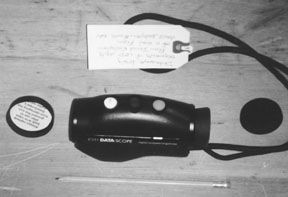The test report in the March 1, 1997 issue of Practical Sailor called the KVH Datascope “the king of the hand-bearing compasses.” Although expensive, it was deemed the best of the half dozen kinds available.

In that report and an earlier 1989 article shortly after it was introduced, PS used words like “very desirable,” “amazing,” “superb” and “wizard.”
What many of Practical Sailor’s tests cannot do with precision is project longevity. That’s where readers can serve each other. By reporting failures and sending them to Gear Graveyard, readers enable Practical Sailor to pursue causes, answers and, ultimately, encourage the improvement of many marine products.
This Gear Graveyard item on the KVH Datascope is an example. KVH’s 5 x 30 monocular Datascope not only takes, times, averages and stores nine bearings, it’s also a stopwatch, chronometer and rangefinder. You can even crank in variation.
The Datascope lists for $450 and discounts for around $350. To KVH’s credit, the price has not changed in a dozen years. (“Hockey puck” type compasses range from $25 to about $100.)
The Datascope’s prolific data is displayed in seven-segment LCD numerals. In a seven-segment liquid crystal display, every segment is needed to make combinations denoting 0 to 9. The numeral 8 uses them all at once. Because the liquid crystals’ reflectivity (meaning visibility) is controlled simply by varying the input voltage, LCDs are considered to be extremely legible and reliable.
However, lose even one of the seven bits and a 9 can become a 5; a 7 can become a 1; a 6 can be a 5; an 8 can become a 6 or a 9 or a 0, etc. You might make the tricky combinations into an “Ask Marilyn” question, but for sure you’ll thereafter regard the Datascope as something between unreliable and useless.
Practical Sailor has had over the years a half-dozen complaints about the Datascope.
Most recently, George Reiser, of Lincoln, Massachusetts, wrote to say that he enjoyed very much his Datascope, which he bought four years ago.
“But when several segments of the LCD display stopped functioning, I was disappointed,” he said. “But I assumed it could be repaired at a reasonable cost. I was shocked when told it was a sealed unit and I might just as well throw it away.
“Why should anyone pay more than $300 for something that doesn’t outlast a Bic lighter?”
Practical Sailor kept his letter.
It certainly wasn’t the first time we’ve been confronted with this downside of today’s otherwise marvelous electronics.
In January of this year, another reader, Dave Kallgren, who is off cruising (currently in Mexico), wrote:
“My Datascope has lost some segments. Some read-outs are barely decipherable; others resemble hieroglyphs. This is the second time around for me. I paid the price once.”
Kallgren said Adam Cloutier, in KVH’s Technical Support, e-mailed him that KVH will replace a unit in the first year at no cost. In the second year, the cost is $178, the third year $222.50, the fourth year $311.50 and the fifth year $378.25…which is more than West Marine’s discount price.
“I can’t afford to replace a relatively expensive instrument every few years,” Kallgren said, “so I will be looking at hockey pucks.”
He sent his Datascope to Practical Sailor’s Gear Graveyard column and we took it to KVH’s offices in Middletown, Rhode Island. We met with Rick Jones, KVH’s quality manager. Our first question was, “How often do Datascopes lose LCD segments?”
Jones said that although several thousand Datascopes had been sold in the last year, only four had been returned, one because the batteries were exhausted, one for an as yet unknown cause, and two for missing LCD segments.
Asked if a missing LCD segment should be considered a manufacturing defect, Jones said, “Yes.”
Asked why KVH does not replace at no cost any Datascope with such a defect, Jones said, “We think our policy is quite liberal…and we apply it very liberally.”
He agreed that KVH’s policy amounts to a one-year warranty, with diminishing protection over the next three years. He explained that no company that produces a commercial-grade product can give a “forever” warranty.
That’s true, but it seems to us that a manufacturing defect is just that. KVH is in a tough spot — if dozens of relatively new Datascopes were being returned with defective displays, the answer would be to find a supplier who makes a more resilient LCD screen. But with an LCD failure rate of a few per several thousand, KVH, we think, should pat themselves on the back for nearly flawless workmanship, and with the other hand give replacements to those few unlucky enough to have landed with the rare weed in the grass.



































I received a Datascope as a gift many years ago. I found it to be an exceptionally usefull tool in navigating our PDQ around the Carribean. After about two years the LCD faded and it was reduced to being a somewhat handy monocular, especially in higher seas when one hand was needed for personal balance and safety but its’ main purpose became an interesting paperweight to show to onboard visitors.
I recently came across it while reorganising an onshore closet.
John Raby. I purchased mine in the UK in about 1992 when living and sailing in Oman. Worked very well for about 10 years and then decided to retire early. Just stopped working and nothing you can do about it. About time we had a movement back to repairable devices to avoid disposing of these seemingly well engineered and built devices. Too good to throw away Marc!